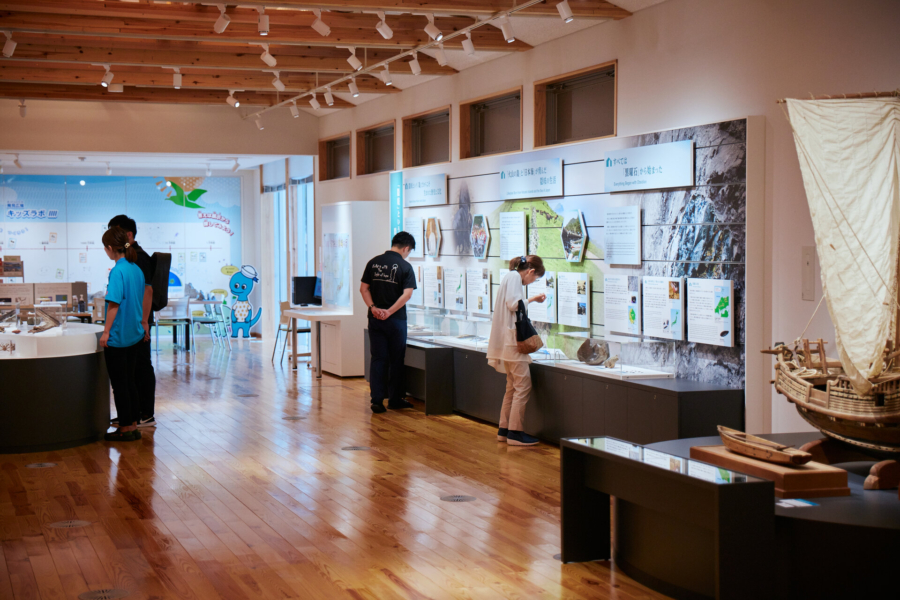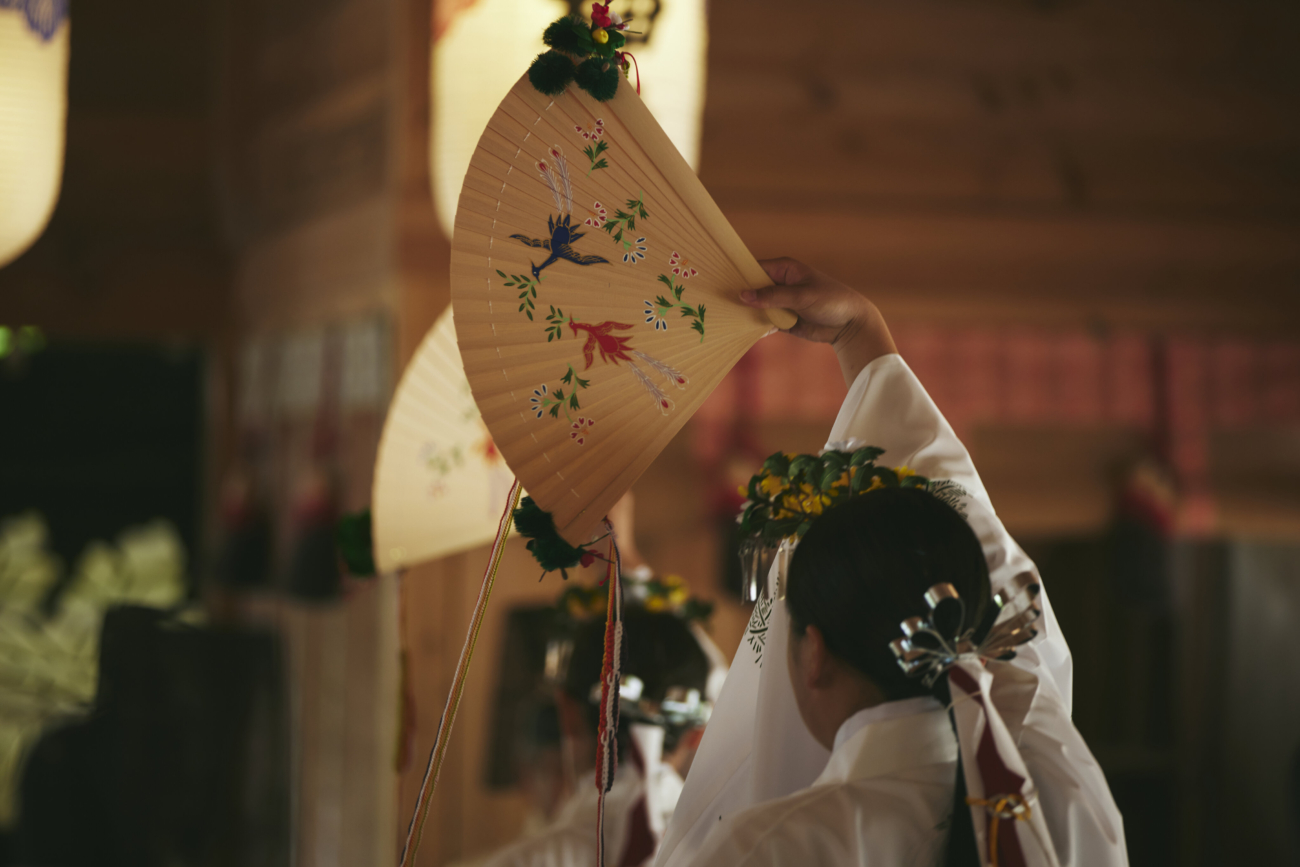It Begins with Obsidian
Obsidian is a kind of volcanic glass that is formed when viscous lava cools quickly. It has very sharp edges when broken and was highly prized by prehistoric people for making stone tools. Chemical analysis has identified obsidian in as many as 100 locations around Japan, but the Oki Islands is one of just six such places where the quality was high enough for toolmaking. Obsidian was found in the 5.5-million-year-old rock layers along the coast in areas of Dōgo Island, but the quality varies. It is thought that only three regions on the island produced the high-quality obsidian: Kumi, Kamo and Sai.
Oki obsidian was sought after by people in different regions of Japan from as early as 30,000 years ago, and these interactions began to shape the culture of the islands. Excavations have shown that Oki obsidian was traded mainly in the Chugoku region (modern-day Hiroshima, Okayama, Shimane, Tottori and Yamaguchi prefectures). However, it has been found as far north as Niigata Prefecture and east to Shikoku. The Oki Islands are also mentioned in the Kojiki—the oldest existing record of Japanese history and ancient mythology—which was completed in 712. According to Japan’s origin myth, the Oki Islands were the third islands to be created by the gods Izanagi and Izanami, following Awaji Island and Shikoku. This prominent mention in the Kojiki in the eighth century suggests that the imperial court valued the Oki Islands and its obsidian.
Emperors in Exile
In 724 the Oki Islands were established as a place of exile for those who fell out with the ruling powers. At first it was important people who came, such as aristocrats, high-ranking officials and even two emperors, although by the middle of the Edo Period (1603-1867) petty criminals were being banished to the islands, too. While being exiled to the Oki Islands was a punishment, emperors and aristocrats could not be sent to places where they would experience great hardship. The remote Oki Islands were considered an ideal location, as they had abundant resources and a rich culture.
Emperor Go-Toba (1180 to 1239) was sent to Ama Town on Nakanoshima Island after being defeated by the shogunate during the Jokyu Rebellion in 1221, remaining there for 19 years until his death at the age of 60. It seems that the emperor lived quite comfortably, writing waka (Japanese poems) and endearing himself to the local people. Oki Shrine (Ama Town) was built in 1939 to commemorate the 700th anniversary of his death. Find out more about his influence on the culture of the islands by visiting the shrine and the nearby Emperor Go-Toba Museum.

In 1332 Emperor Go-Daigo (1288 to 1339) was banished to the Oki Islands for similar reasons as Go-Toba. It is thought that he probably lived on Nishinoshima Island, although some stories say it was Dōgo Island. What is clear is that he was only in the Oki Islands for about a year, before making a daring escape back to Kyoto, the capital of Japan at the time. He won back the Japanese throne, only to be overthrown again. Go-Daigo subsequently established his own court in the Yoshino Mountains to the south of Nara in 1337, where he died two years later. You can visit the site of his former home and learn more about him at the Kuroki-gosho Imperial Residence Site & Hekifū-kan Museum (Nishinoshima Town).
Traditions Shaped by Land and Sea
Makihata Farming
The Oki Islands is characterized by a mountainous landscape with relatively little land suitable for farming. In the past it was very difficult to bring goods over from the Japanese mainland on a regular basis, so the islands had to be self-sufficient in terms of food production. Makihata is a uniquely Oki method of rotating crops and stock. Fields were divided into four sections, marked by stone walls. Each section was rotated through a four-year-cycle of pasture for grazing and for cultivation of crops such as millet, soybeans and wheat. Manure from cattle and horses helped to provide nutrients to ensure that crops grew well. Although it is not clear when makihata was first developed, it is mentioned in written records from the thirteenth century. This efficient and sustainable way of producing food was practiced right up until the early 1970s, with Chiburijima being the last of the four islands to finally give up the practice. You can see the remains of stone walls on Chiburijima Island near the top of Mt. Akahage.
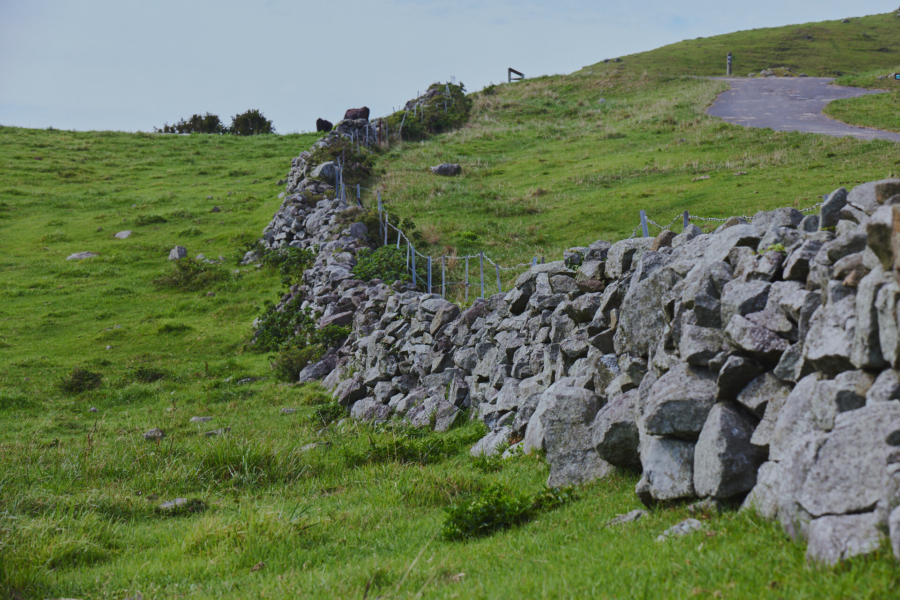
Funagoya (Boathouses)
Fishing has been an integral part of daily life for Oki islanders for centuries. Wooden fishing boats had to be protected from the elements and from mollusks when not in use. In Tsuma (Okinoshima Town) you can see some funagoya, small boathouses built from traditional methods: rooves made with cedar bark, with rocks from the shore and bamboo laid on top.
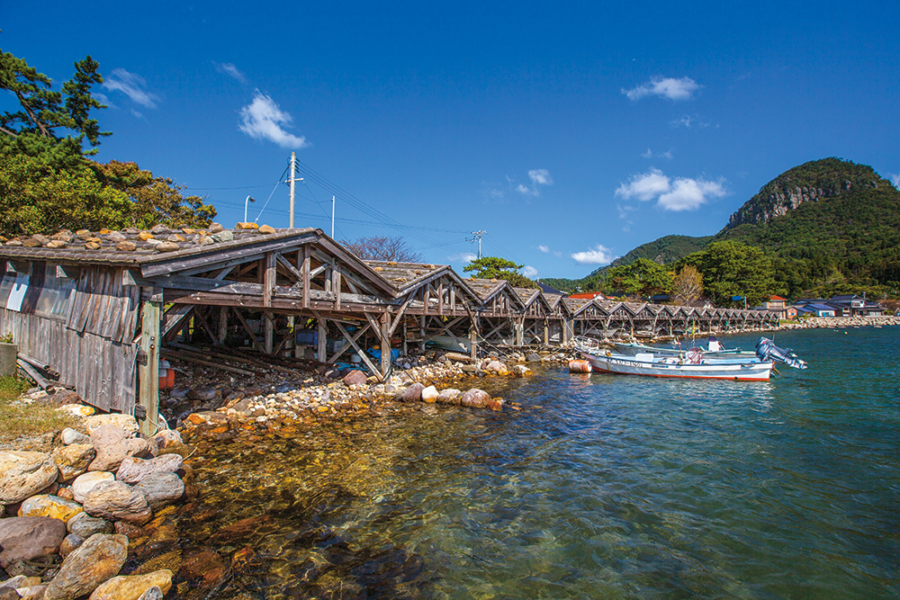
The funagoya sit right on the shore, so that the boats can be easily pulled inside directly from the water. This is possible due to the fact that the Oki Islands are located in the Sea of Japan, where the difference between low and high tide is only around 50 centimeters. You will not see these types of boathouse along Japan’s Pacific coast, because the tides may vary between two and five meters, making it very difficult to pull boats ashore.
Kitamaebune (Merchant Ships)
Kitamaebune were ships that sailed between Osaka and Hokkaido from the mid-Edo Period to the end of the nineteenth century, transporting food products and goods. They followed a route along the coast of the Sea of Japan, stopping at ports on the way. The sails on the early ships were not very durable, and so they could only make one round trip per year between Osaka and Hokkaido. Textiles had improved by the 1780s, however, and the ships could manage two round trips a year along a new route that connected Shimonoseki (Yamaguchi Prefecture), the Oki Islands and Sado Island (Niigata Prefecture).
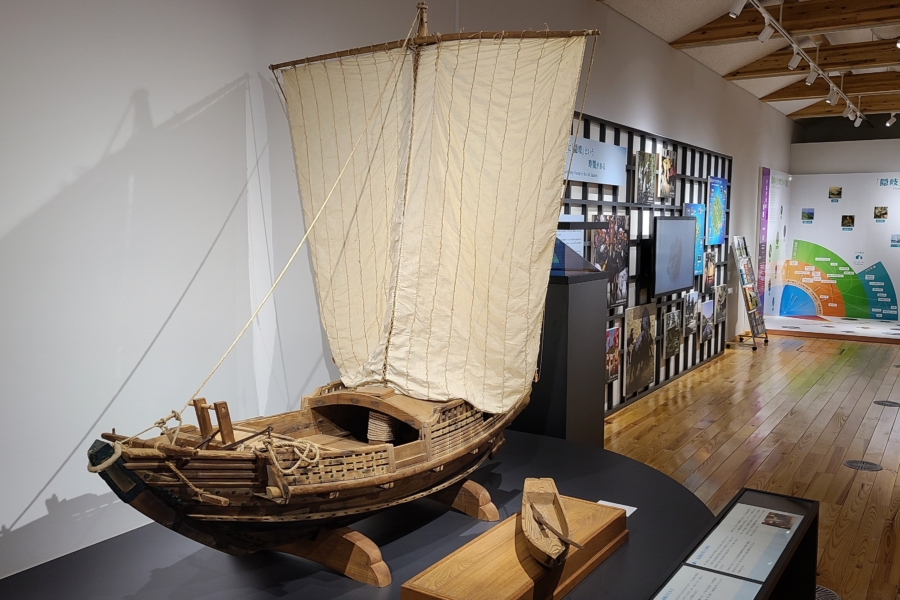
Kitamaebune trading ships began visiting more frequently and the Oki Islands served as a port of call and supply base. In turn, the ships bought news and culture from other places. More than 4,500 of these ships sailed into the ports of the Oki Islands in some years. Takuhi Shrine on Mt. Takuhi (Nishinoshima Town) honors the deity of maritime safety, and sailors setting out on the kitamaebune route would offer prayers as they passed by.
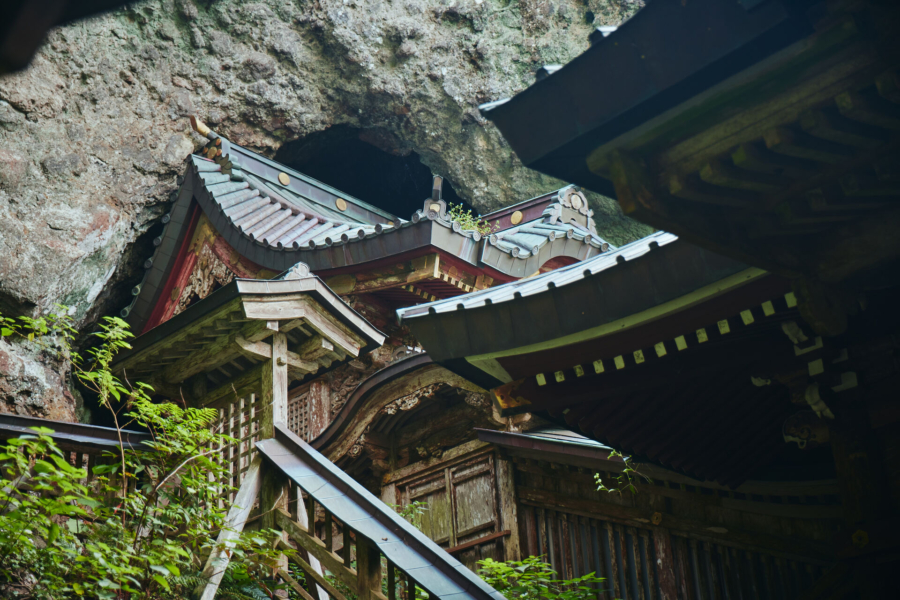
Lafcadio Hearn
The famous Irish writer and scholar Lafcadio Hearn (1850-1904, also known by his Japanese name, Koizumi Yakumo) visited the Oki Islands in 1892. He lived in Japan for 14 years and met and married his wife, Setsu, in the city of Matsue in Shimane Prefecture. Hearn wrote very favorably of his visit to the Oki Islands in his book Glimpses of Unfamiliar Japan Volume 2 (1894), praising the kindness of the people and expressing his love for the islands. You will find statues of Hearn and his wife sitting on a bench in a small park called Yakumo Square in Ama Town.
Cultural Practices Steeped in Ceremony
Oki Kagura
Kagura is a Shinto religious ritual, with dancing and singing performed in honor of the gods. The nearby Iwami area of Shimane Prefecture is very famous for kagura, but the Oki Islands has its own version that has been passed down through the generations. This kagura was only performed by specialists called shake from certain families in the past, but these days local residents can perform the dances. Oki KaguraThis will open in a new tab. can be divided into Dōzen and Dōgo Kagura, and there are a number of differences between the two: The music is fast and quite lively in Dōzen Kagura, and the dancers perform on a stage the size of four tatami mats. Dōgo Kagura, on the other hand, is performed to slower, more solemn music on a stage the size of just two tatami mats.
Oki Traditional Sumo
Did you know that sumo started as a ceremonial ritual, not a sport? It was performed at Shinto shrines on important occasions to pay respects to the gods. Oki Traditional Sumo has generally been held as a celebration of an important event, for example when the roof of Mizuwakasu Shrine in Okinoshima Town (one of the highest-ranking shrines in the Oki Islands) is rethatched.
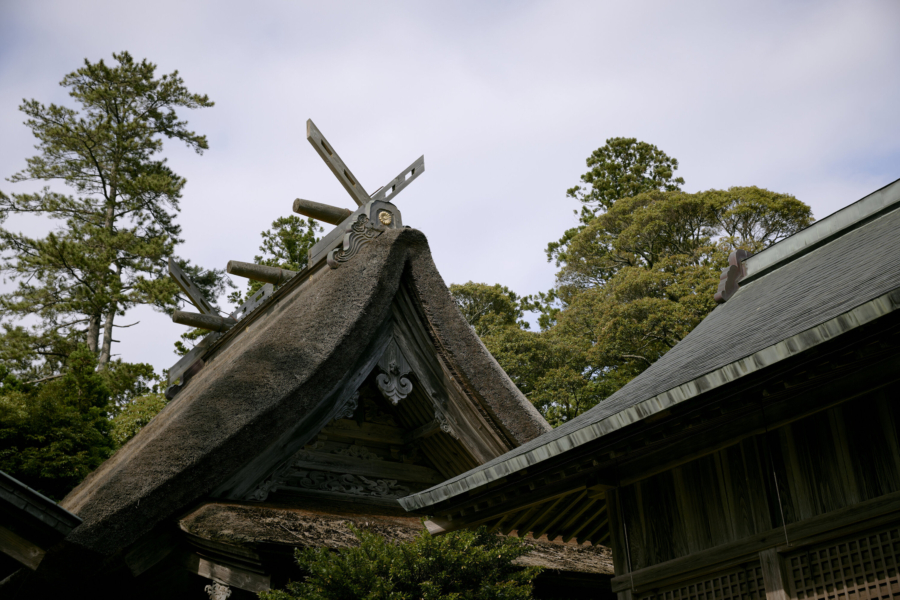
These days it also takes place when a new public facility is opened, with performances continuing throughout the night. Unlike regular sumo, the spectators join the wrestlers in tossing salt to purify the sumo ring. Another unique aspect is how all the sumo wrestlers compete against each opponent twice. The winner of the first bout must let his opponent win in the second, so each wrestler will have one win and one loss. This was a way to ensure harmonious relations in the small communities on the islands. For this reason, Oki Traditional Sumo is sometimes called ninjo sumo (compassionate sumo).
Bull Sumo
Bull wrestling, whereby two bulls compete against each other, can be found in a number of places, but the bull sumo of the Oki Islands is thought to be the oldest in Japan. It is said that Emperor Go-Toba (who was exiled to the Oki Islands in 1221) came up with the idea after watching two calves butting heads together. The basic concept has been passed down to the present day, with two handlers overseeing the bulls. The bout ends when one bull turns away from the fight, and the other is declared the winner. As with Oki Traditional Sumo, the bulls are ranked and their performances are steeped in Shinto ceremony. There are six official performances a year, along with demonstration bouts at other times.
Rengee-mai Dances
The colorful Rengee-mai DancesThis will open in a new tab. are performed to traditional music every year at Oki Kokubun-ji Temple (Okinoshima Town). While the Oki Islands have a strong association with Shinto, there are also deep connections with the Buddhism religion. With a history that dates back to the Nara Period (710-794), Oki Kokubun-ji is considered the most important among the temples in the Oki Islands.
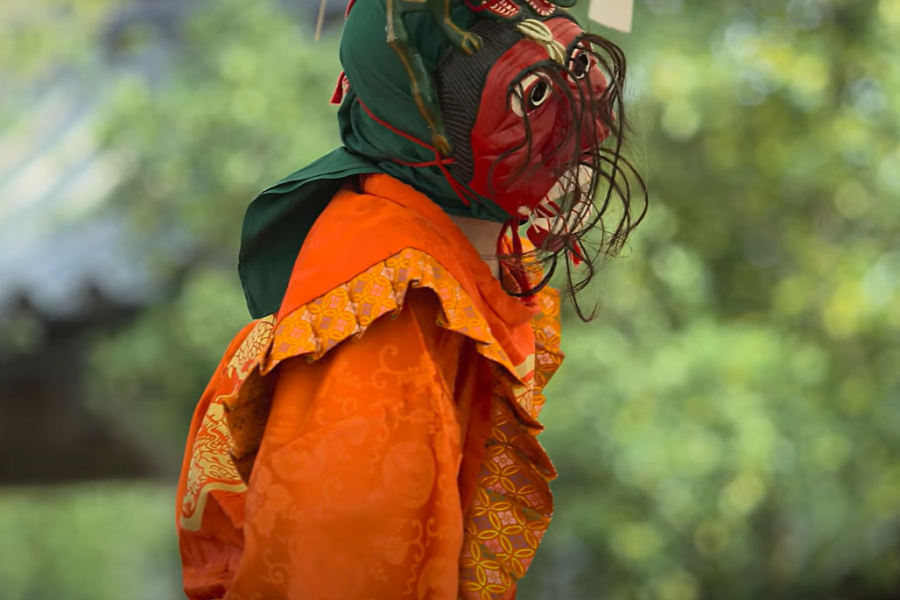
The performances take place on April 21, the anniversary of the passing of Kōbō Daishi (also known as Kukai, 774-835). This revered monk and scholar was the founder of the Shingon School of Japanese Buddhism and he is a central figure in Buddhist legends throughout the country. Rengee-mai is thought to have come to the Oki Islands more than 1000 years ago, and as many as 120 different dances were performed in the past. Today seven are still performed every year on a wooden stage inside the temple grounds. Rengee-mai Dances have their roots in bugaku—dance and music that came to Japan via China, Korea, India and Southeast Asia. Drawing on elements inherited from these other cultures, Rengee-mai dancers wear brightly-colored masks and costumes. The expressive sounds made by the performers with their feet is another feature of these eclectic dances.
If you would like to see kagura, sumo or bull sumo during your trip, please consult with the staff at the Oki Islands Geopark Management Bureau either by phone or by sending an inquiry form.
Learn More about Oki History
You can discover more about the history of the islands at the Oki Islands Geopark Museum, located next to the ferry terminal in Okinoshima Town. This very informative museum is a great place to start your Oki Islands adventure and will help you to see how everything connects together. Another interesting museum is the Nishinoshima Furusato-kan (Nishinoshima Town), with displays about the specific history and culture of this island.
